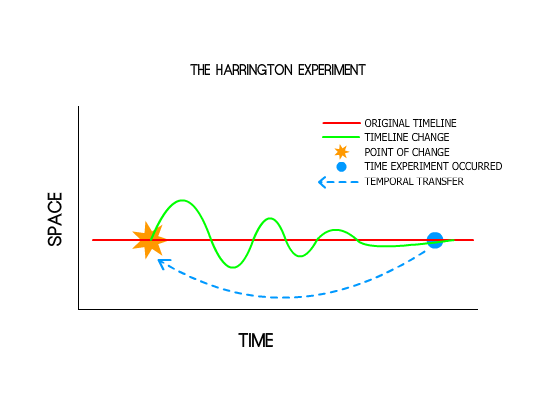As established already*, Liang Oscillation is the behaviour exhibited by the continuum of spacetime when altered. The quantum states of particles are defined by the 5th ‘meta dimension’, which is best thought of as the path of spacetime. When a Chrononaut alters past events (or visits them), they enact a change on the shape that spacetime occupies in the meta dimension.
Plotting a space-time graph, we can imagine the history of a complex system to be represented as a line. From an abserver looking at this history the system’s history is fixed. To the present, the past is a straight line and the future is non existant. Now, if we make a small change to the system at a point some time ago, spacetime will ‘veer off’, as a sequence of chaos amplifies to make a very immediate change. This ‘butterfly effect’ was predicted by Chaos Theory as early as 2.0.C. However, unknown at the time, a curious property of the meta dimension is that the path of quantum probability has an ‘optimum’, almost like a river settling into a valley. This leads a change in the system to eventually reverse and invert repeatedly, our ‘line’ of spacetime waving up and down until the deviances slowly converge and the system’s distant future is largely unchanged from how it was originally; hence the ‘occillation’ Dr Liang postulated in 2.9.C.
The problem with trying to measure this effect was one of relativity. To the observer in the present, any change to the past has already happened. This is why the impact and effects of actions on complex systems such politics or meteorology remained poorly understood long into the third millenium.
In early 3.1.C, A North American scientist named Jan Harrington set out to demonstrate Liang’s theory, using a device that could measure spacetime changes. By isolating itself in a feedback loop, the device could record the spacetime history of its closed system in the present, then send a ‘change’ into the past. But as it did so, it also sent its own complete data back to its earlier self for comparison (as the ‘previous version’ of the present would no longer exist).
The device, measuring the atomic arrangement of a gas canister, showed the change inside the system from previous timelines as a ‘sine wave’ ripple, with a duration proportionate to the impact of the change: just as Dr. Liang had predicted. By proving Liang Oscillation, the Harrington Experiment had made a profound discovery; that time is indeed somewhat elastic. It suddenly seemed possible that one may be able to traverse it without total dissolution of one’s origin.

